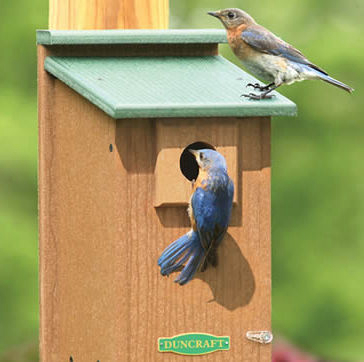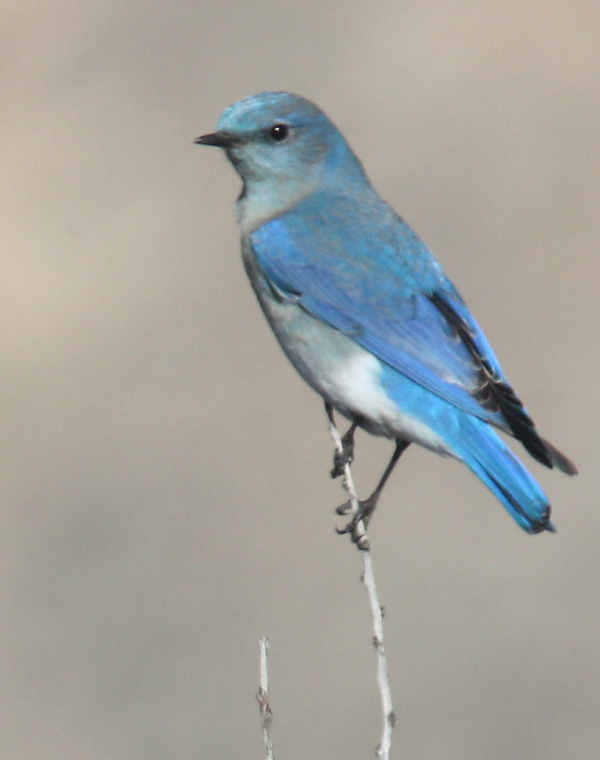
Eastern Bluebirds are one of the most popular cavity nesting birds, along with Western and Mountain Bluebirds. Due to a lack of natural cavities and competition from non-native birds, many birders like to provide artificial nesting sites in the form of nest boxes.

Mountain Bluebirds are always welcome sights, and to attract a pair to a nest box is a goal for many birders.
|
Bluebirds may be the most popular cavity nesting birds among birders, but they require a few special considerations if you are trying to attract them to your property or a natural area. There are three species of bluebirds in North America, all well-named for their range in the United States: Eastern Bluebirds range across the eastern half of the country, Western Bluebirds range from the western Great Plains west to the Pacific Ocean, and Mountain Bluebirds inhabit the Rocky Mountains, the Cascades and Sierra Nevada Range and surrounding areas (excluding deserts). Which bluebird species nests in your area?
Bluebirds are not typically backyard birds; instead, they tend to be found in rural areas, on the edges of towns or in suburban areas where properties are an acre or more in size. Open rural landscapes are most attractive to bluebirds, where there are grasslands or meadows and few trees. With this in mind, many “bluebird landlords” organize with property owners, nature centers, refuges, railroad or highway right of ways, or interested farmers or ranchers to install their nest boxes. A popular activity for some birders, birding clubs, or scout groups is to develop a nest box trail, which may be fashioned just for bluebirds, but may include other cavity nesting birds like wrens, chickadees, Tree Swallows, and others – possibly including a few larger nest boxes for screech owls, Wood Ducks, or American Kestrels.
It’s worthwhile to study bluebirds to become familiar with where they are found and how they behave in advance of any attempts at attracting them with a nest box or a series of appropriately constructed nest boxes. So what makes an appropriate bluebird nest box?
Nest Box Construction
The most important element of any nest box is the size of the entrance hole – if it’s too small, bluebirds are not able to enter, but if it’s larger than necessary, larger birds will compete and even evict bluebirds. So be specific when building or buying a nest box for bluebirds! Even among the three bluebird species, the size of the entrance hole varies a bit.
For Eastern and Western Bluebirds, the entrance hole should be 1½ in diameter, and for Mountain Bluebirds the entrance hole should be 1 9/16 inches in diameter. However, in some areas, bluebird experts prefer to make all their entrance holes 1 9/16 inches in diameter. As for the overall size of the nest box, 9 inches high and 5¼ x 5¼ inches wide is considered an optimum size.
The best nest boxes will feature a slanted roof to repel rain, thick walls for insulation, small ventilation holes drilled at the top of the nest box, drain holes on the bottom corners of the recessed floor of the nest box, interior grooves beneath the entrance to help when nestlings are ready to fledge and climb to the entrance hole, and – a very important feature – a hinged door, usually on one side of the nest box. For more information, seehttps://nestwatch.org/learn/all-about-birdhouses/features-of-a-good-birdhouse/
Predator-Proofing
Without adequate predator-proofing, you are endangering the birds you attract to your nest boxes. Potential predators include snakes, raccoons, chipmunks, and cats. Three predator are featured at https://nestwatch.org/learn/all-about-birdhouses/birds/mountain-bluebird/
If you plan to build your own bluebird nest box or boxes, you can get specific construction plans for nest boxes for each species of bluebirds (including plans for nest boxes for all cavity nesting birds in America), refer to https://nestwatch.org/learn/all-about-birdhouses/birds/western-bluebird/ for Western Bluebirds, but for Eastern Bluebirds see https://nestwatch.org/learn/all-about-birdhouses/birds/eastern-bluebird/ and for Mountain Bluebird nest box plans go to https://nestwatch.org/learn/all-about-birdhouses/birds/mountain-bluebird/
Positioning
Position nest boxes 4 feet to 6 feet above ground so each nest box entrance hole faces east toward open habitat, preferably open grassland, a hayfield, or meadow on the edge of open woodland, although open woodland is not necessary. If you are installing more than one nest box for bluebirds, be sure to position them a minimum of 300 feet apart (400 feet apart is even better) to allow for the territorial behavior of nesting pairs of bluebirds.
Tree Swallows, another popular cavity nesting species, are often attracted to nest boxes meant for bluebirds, so birders have learned to reduce nest box competition with Tree Swallows by providing a pair of nest boxes about 15 to 20 feet apart, with pairs of nest boxes positioned a minimum of 300 feet apart, or more.
Maintenance
Clean old nests and any debris from each nest box as soon as a brood fledges so the nest box can be used for a second nesting attempt. This timely maintenance is obviously important, and that’s when the hinged door or side panel of the nest box is so important (as referred to above). Double check the latch to make sure it holds the door closed securely, and check for any indication of predator activities on and around the nest box and its pole.
If some nest boxes are not used over time, you may consider moving them to another location that may be more attractive to bluebirds. Then again, be patient too, because sometimes it takes a couple seasons to attract bluebirds to a given nest box.
Always keep in mind that not all nesting attempts are successful. Don’t take any unsuccessful nesting attempts personally, as long as you have provided protection from predators and other potential nest box problems such as drainage. Take a moment to see if there are any improvements you can make to your nest box and its surroundings; then clean out any nesting material and other debris, then wait for the next birds to start all over.
Finally, provide the results of any nests that are initiated in each of your nest boxes – whether successful or not – with NestWatch at https://nestwatch.org/. NestWatch is a part of the Cornell Lab of Ornithology’s citizen science efforts, and the information you provide help in a variety of ways, now and in the future. For instance, a new study based on Ohio’s Eastern Bluebirds and Tree Swallows sheds light on how future climate scenarios might impact nesting birds. The study was recently published in the journal American Midland Naturalist and included 4,417 NestWatch records. Distilling 16 years of first egg laying dates, the research examined how the timing of egg laying overlaps with insect pest emergence in Ohio, and how cavity-nesting birds might help benefit farmers in Ohio.
So the moral of this article is that there is more to buying or building a nest box or bird house and offering it to bluebirds than you may have expected. There is planning, important protections, and some timely maintenance to keep in mind. But now you’re on the right track to being a better birder as you provide much-needed artificial nesting cavities – nest boxes and bird houses (the same product with different names) – for bluebirds and other cavity nesting birds. Enjoy the season!
For more information about bluebirds, bluebird nest boxes, and bluebird trails, you can also refer to information provided by the North American Bluebird Society (NABS) at http://www.sialis.org/startingatrail.htm and for a broader view of bluebirds, see http://www.nabluebirdsociety.org/PDF/NABSFactsheetGettingStarted.pdf
Share your backyard birding experiences and photos at editorstbw2@gmail.com